Designed for Smart Home or industrial IoT (IIoT) applications, Waveshare’s ESP32-P4 Smart 86 Box is equipped with a 4-inch square touchscreen display, an ESP32-C6 module with WiFi 6 and Bluetooth connectivity, and a range of connectors.
Two models are offered: the ESP32-P4-WIFI6-Touch-LCD-4B with a MIPI CSI camera connector and a 28-pin GPIO header, and the ESP32-P4-86-Panel-ETH-2RO with a bottom board that features an RS485 serial interface, two relays, a 10/100Mbps Ethernet RJ45 connector, and 6V-30V DC input.
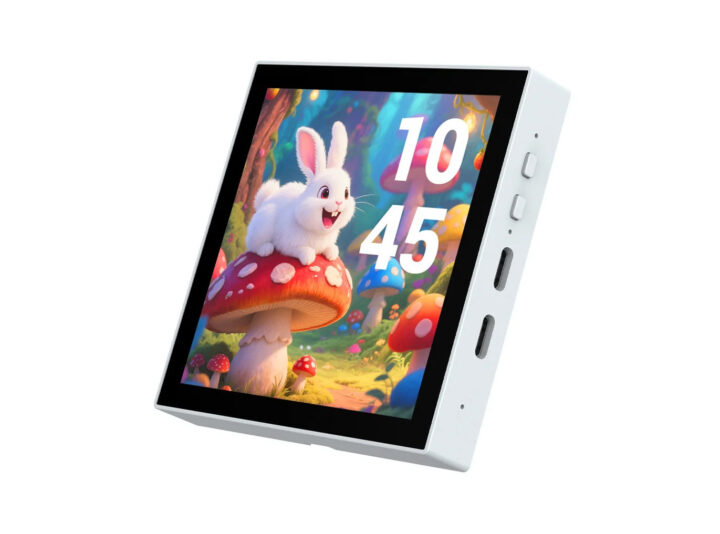
ESP32-P4 Smart 86 Box specifications:
- Main module – ESP32-P4-Core Module
- Microcontroller – ESP32-P4NRW32
- MCU
- Dual-core RISC-V microcontroller @ 400 MHz with AI instructions extension and single-precision FPU
- Single-RISC-V LP (Low-power) MCU core @ up to 40 MHz
- GPU – 2D Pixel Processing Accelerator (PPA)
- VPU – H.264 and JPEG codecs support
- Memory – 768 KB HP L2MEM, 32 KB LP SRAM, 8 KB TCM, 32MB PSRAM
- Storage – 128 KB HP ROM, 16 KB LP ROM
- MCU
- Storage – 32MB NOR Flash
- Microcontroller – ESP32-P4NRW32
- Storage – MicroSD card slot
- Display – 4-inch MIPI DSI RGB LCD with 720×720 resolution, 5-point capacitive touchscreen
- Camera – 15-pin MIPI CSI connector for 2-lane camera (ESP32-P4-WIFI6-Touch-LCD-4B only)
- Audio
- ES8311 low-power audio codec
- On-board microphone with ES7210 echo cancellation chip
- 2-pin 1.25mm pitch header supporting 8Ω 2W speaker
- Networking
- 10/100Mbps Ethernet RJ45 jack (ESP32-P4-86-Panel-ETH-2RO only)
- Wireless – ESP32-C6-MINI-1U-H8 (SDIO) module for Wi-Fi 6 and Bluetooth 5 (LE) connectivity
- USB – 1x USB 2.0 Type-C OTG port
- Serial/Relay
- Isolated RS485 terminal block
- 2x 10A 250V AC / 30V DC relays via terminal block and opto-coupler isolation
- Programming/Debugging
- USB Type-C USB to UART port for power, programming, and debugging
- 4-pin solder pads for flashing the ESP32-C6 module
- Expansion – 28-pin 2.0mm pitch GPIO header for I/Os (ESP32-P4-WIFI6-Touch-LCD-4B only) or bottom board for the ESP32-P4-86-Panel-ETH-2RO model
- Misc
- RESET and BOOT buttons
- Power and Relay LEDs
- RTC battery header connector
- Power Supply
- 5V via USB-C port
- ESP32-P4-86-Panel-ETH-2RO – 6V to 30V terminal block
- Dimensions
- ESP32-P4-WIFI6-Touch-LCD-4B only – 86.5 x 86.5 x 14 mm
- ESP32-P4-86-Panel-ETH-2RO – 86.5 x 86.5 x 30.5 mm
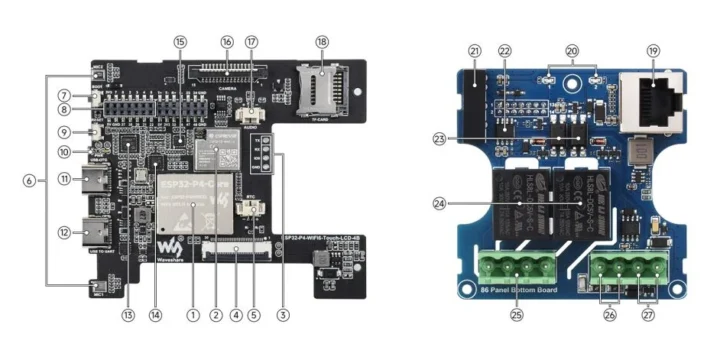
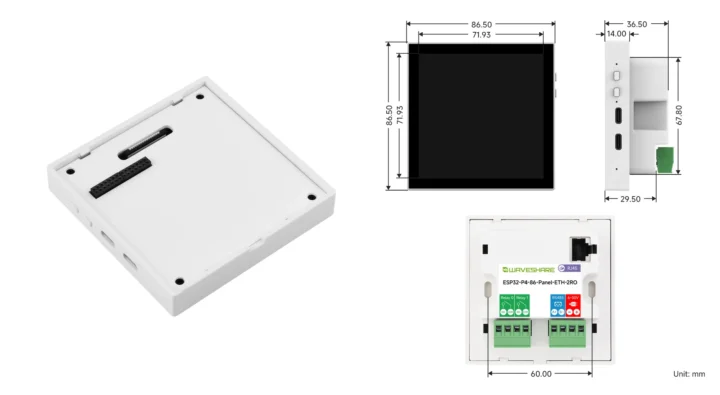
In some ways, the design is similar to the ESP32-P4-WIFI6-Touch-LCD-3.4C/4C controller with a round touchscreen display we covered last weekend, and the main difference is the 4-inch square display and a design suitable for an installation into an 86-type junction box. However, the ESP32-P4-86-Panel-ETH-2RO model brings even more options with RS485, relays, Ethernet, and a wide 6V to 30V DC supply range.
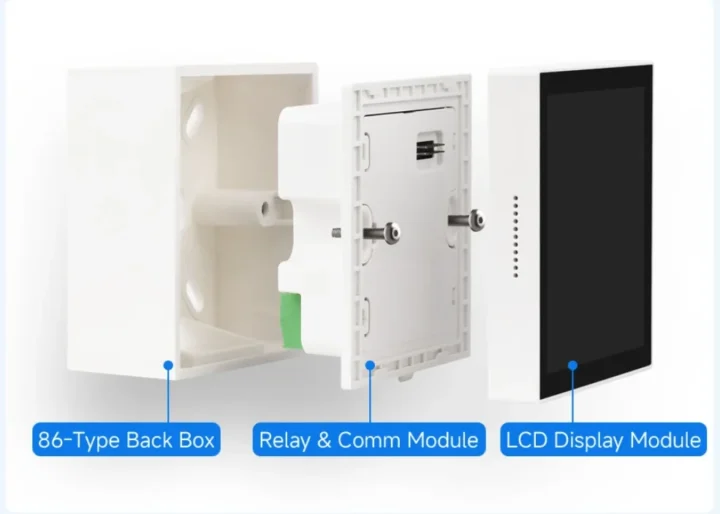
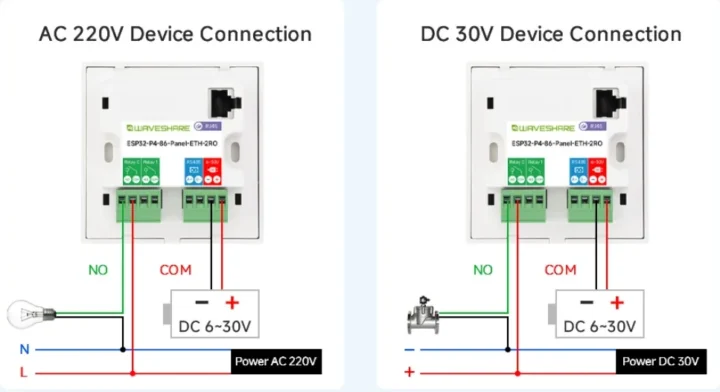
Software/Firmware support is also similar, with development done using the ESP-IDF framework with VSCode (Recommended) or the Eclipse IDE, or the Arduino IDE. Some instructions to get started with the former are provided on the wiki, but as we’ve seen in the M5Stack Tab5 review, the Arduino IDE is already supported on ESP32-P4 devkits with an LCD. The company also explains how to use the LVGL library, convert the kit into a USB display, and load the ESP-Phone firmware based on ESP_Brookesia to show an Android-like user interface.
The design of the ESP32-P4-86-Panel-ETH-2RO variant is very similar to the Luckfox-Pico-86-Panel with the same “bottom board”, but a Linux-powered Rockchip RV1106 main board instead. Both are suitable for environments with DC power input, instead of 110/230V AC power input, or you may need an AC to DC converter.
Waveshare is selling the ESP32-P4-WIFI6-Touch-LCD-4B for $49.99 on AliExpress, and the ESP32-P4-86-Panel-ETH-2RO for $63.99 on the same page. You’ll also find both models on the Waveshare shop for $39.99 and $49.99, respectively, and the ESP32-P4-WIFI6-Touch-LCD-4B is also sold on Amazon for $52.79 by a reseller..

Jean-Luc started CNX Software in 2010 as a part-time endeavor, before quitting his job as a software engineering manager, and starting to write daily news, and reviews full time later in 2011.
Support CNX Software! Donate via cryptocurrencies, become a Patron on Patreon, or purchase goods on Amazon or Aliexpress. We also use affiliate links in articles to earn commissions if you make a purchase after clicking on those links.


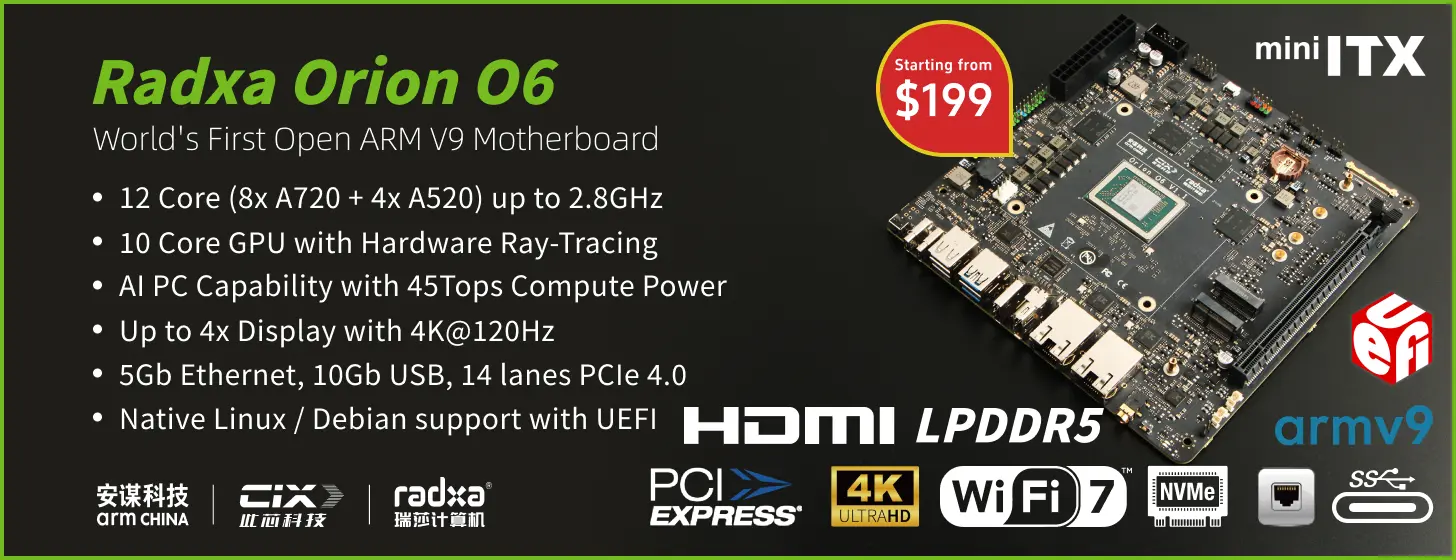


OK, so it’s not the first one, but… Where in the world do they use “86-Type junction boxes”? Is that the standard in China and/or other Asian countries?
Beyond that one wonder why a device that is going into a junction box with 220 V available does not take 220 V directly, and why the Ethernet version doesn’t support PoE either. That’s going to result in some creative wiring or installation…
They’re BS 4662 and BS 5733 I think.
BS4662 is 72×72, not sure what BS5733 would be.
86-type seems to be 86 x 86 mm, and other than a few surface-mounted boxes (rather than flush-mounted which I think is the intended use) I can’t find any boxes of that size in European or North American markets.
Honestly the box size is fine, however the inability to power from 230V or PoE is a dealbreaker, not sure what the designers were thinking.